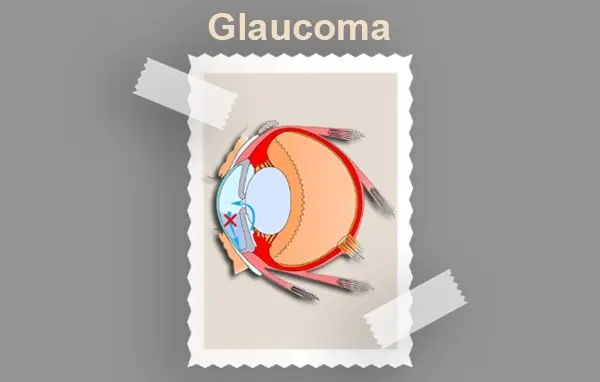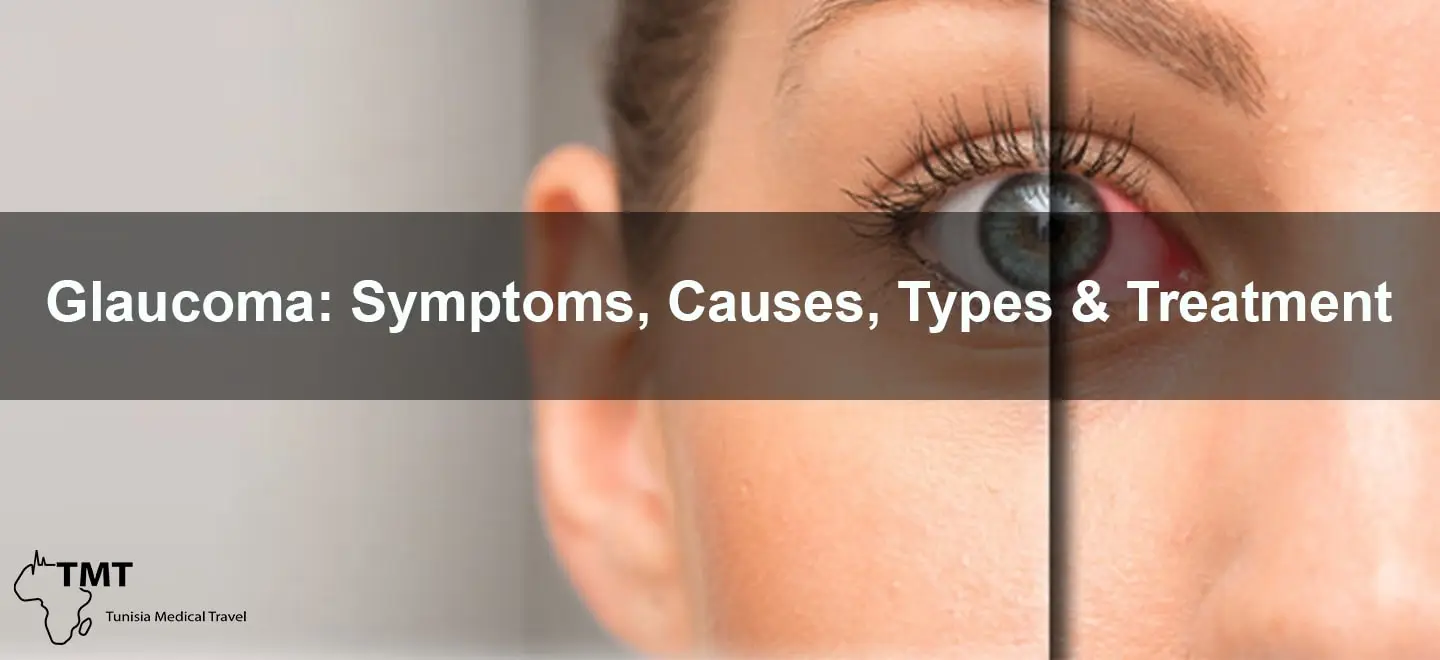Glaucoma: Symptoms, Causes, Types & Treatment
Glaucoma: Symptoms, Causes, Types & Treatment
What is glaucoma?
is a disease that affects the optic nerve and eventually results in vision loss and blindness. The optic nerve connects the eye to the brain and carries the images we see to the brain. Although the reasons for the damage to the optic nerve are not fully understood, it is usually associated with an increase in the intraocular pressure (IOP), commonly called pressure in the eye. The eye is like a water balloon. There is a small amount of liquid constantly being produced to fill the inside of the balloon, and there is an equal amount of liquid being drained out of the balloon. Imagine if the balloon had a kink in it, stopping it from getting rid of the correct amount of water and causing it to go up in size. A small increase in IOP can occur in some patients with the normal amount of fluid. High IOP is the most important risk factor in the development of glaucoma, but people can develop the condition with normal IOP.
How common is glaucoma?
About 2% of the population (or 1 in 50) of the United States over age 40 has glaucoma. At a previous time, glaucoma was thought to be a leading cause of blindness in African Americans. This was based upon results of the Baltimore Eye Survey which showed that glaucoma was the leading cause of blindness in African Americans. However, the recent results show that cataract, not glaucoma, is the leading cause of blindness in African Americans. Despite this, African Americans are still 4 times more likely to be blinded by glaucoma than other races. They are also 6-8 times more likely to develop glaucoma. This is of great concern because it is estimated that over 11 million Americans will have glaucoma and over 50% of these people will be African American or of Hispanic descent.
What are the types of glaucoma?
Open-angle glaucoma
Open-angle glaucoma has various possible treatment options, including eye drops, oral medications, laser surgery, incisional surgery, or a combination of any of these. Classically, open-angle glaucoma has no symptoms until late in the disease course, which usually makes it too late to prevent significant vision loss, and this symptom may not present at all times. If intraocular pressure is very high, there may be sudden pain in the eye, blurred vision, or redness. In more gradual cases, there may be a loss of peripheral vision noticed. Open-angle glaucoma, the most common form of glaucoma, accounting for at least 90% of all glaucoma cases, is an insidious, slow, progressive disease in which aqueous outflow into the trabecular meshwork is impaired. As a result, eye pressure (intraocular pressure) gradually increases, damaging the optic nerve. The open-angle term refers to the angle in the eye that is formed between the iris and the cornea. This area is intended to be open to allow fluid to flow out of the eye, so the fluid will not build up and cause high eye pressure. In open-angle glaucoma, the angle remains open, but the fluid does not flow out of the eye as well as it should, causing an increase in eye pressure.
Closed-angle glaucoma
This is also known as acute glaucoma or narrow angle glaucoma. It occurs when the drainage system of the eye becomes blocked. The cause of the block is the iris being too close to the drainage system which is at the edge of the cornea. The outer part of the iris bunches up and blocks the drainage angle of the eye. This then causes a sudden increase in the pressure of the inner eye. This can cause severe pain, nausea and vomiting, redness of the eye and blurred vision. An acute attack is a medical emergency, if you have any of these symptoms you should aim to go to your nearest eye casualty without delay. The treatment for closed angle glaucoma is usually by laser to make a hole in the iris to allow the eye fluid to flow more freely, this is the peripheral iridotomy. This treatment can prevent further attacks though any loss of vision which has occurred from the attack may not be fully reversible. Sometimes people have both types of glaucoma, it is then known as mixed mechanism glaucoma. This is because the type of glaucoma can convert to the other type due to various factors and a combined treatment may be needed. Any suspected acute attack should be referred to an ophthalmologist without delay as an urgent case.
Normal-tension glaucoma
Normal-tension glaucoma (NTG) is a variant of open-angle glaucoma in which optic nerve damage and visual field loss have occurred despite a statistically normal intraocular pressure. There are many theories to explain the discrepancy, including an abnormally low, but pathologically elevated, cerebrospinal fluid pressure, an abnormally high trans-lamina cribrosa pressure differential, and an increased susceptibility of the optic nerve to pressure-related damage. NTG is almost exclusively a disease of the primary open-angle glaucoma group and shares many of the same characteristics, including presenting symptoms and treatment. As is the case with all primary glaucomas, the purpose of treatment is to halt progression of the disease, as any existing visual field loss or optic nerve damage cannot be reversed. NTG is a chronic condition, and the majority of patients will require treatment for life. The treatment strategy is generally analogous to that of high-tension glaucoma, beginning with the use of anti-hypertensive eye drops. Several large, multicenter, randomized controlled trials have shown that lowering intraocular pressure is effective in slowing progression of the disease. If progression continues, then the next step is laser or, less commonly, incisional surgery. The aim of surgery is to further lower intraocular pressure and hence reduce the rate of progression. However, it is important to note that NTG is less responsive to pressure-lowering treatment than high-tension glaucoma. Another theory explaining NTG is the concept of fluctuation of intraocular pressure. It has been shown that NTG patients tend to have a greater diurnal fluctuation of intraocular pressure compared to both high-tension glaucoma patients and controls. There is also some evidence to suggest that intermittent ocular hypotensive episodes may be a risk factor for optic nerve damage. In light of this, some have advocated use of medication to reduce diurnal fluctuation, such as prostaglandin eye drops and carbonic anhydrase inhibitors. This may become an increasingly important aspect in the management of NTG.
Congenital glaucoma
Glaucoma is different than adult-onset glaucoma in that the aqueous outflow pathways of the eye become obstructed or blocked, which leads to elevated intraocular pressure and enlargement of the eye. Hindered formation and development of the aqueous outflow pathways result from improper development of the structures in the front of the eye. Infants that inherit one of the several prominent forms of congenital glaucoma experience symptoms differing from other types of glaucoma, including excessive tearing, light sensitivity, and cloudiness of the cornea. Treatment for infantile glaucoma typically includes surgery to repair or bypass the abnormal aqueous outflow pathways. A procedure called goniotomy is a surgical approach to cleansing the eye’s drainage system. This is often indicated for congenital glaucoma if it is associated with angle abnormalities. Another procedure for removing the blockage of the trabecular meshwork is a minimally invasive surgery called trabeculotomy. If the glaucoma is more severe with extensive corneal enlargement and cloudiness, the child may require a corneal transplant to restore vision. Although surgery in infants might seem complicated and may carry long-term risks, the potential benefits and improved quality of life for the child often outweigh the risks. Long-term data has shown that with early diagnosis and proper treatment, many infants can have successful results in managing their intraocular pressure.

What are the symptoms of glaucoma?
Acute angle-closure glaucoma is a much more symptomatic disease, the attack comes on out of the blue most of the time. Symptoms of acute angle-closure glaucoma are very noticeable and damage very quickly. They include headaches, mild eye pain or redness, and a decreased or blurred vision. A person who experiences any of these symptoms should immediately consult an ophthalmologist or go to the emergency room. Prompt treatment is necessary to prevent severe vision loss or blindness. An examination ahead of time can detect if a patient is at risk for developing this form of glaucoma. Primary open-angle glaucoma has no symptoms. By the time the patient notices vision loss, the disease is very advanced. This is a form of chronic glaucoma. The most common forms of glaucoma, primary open-angle glaucoma and acute angle-closure glaucoma, have completely different symptoms. Glaucoma can cause slight to severe vision loss, and is often discovered only after the disease is present—it usually has no warning symptoms and the pain is often first experienced during an attack of acute angle-closure glaucoma. Because vision loss is so gradual, people with chronic glaucoma often adjust to a vision change without realizing it.
What causes glaucoma?
Studies have shown that Inuits in Alaska and people from Central and South America are at an increased risk of developing acute angle closure glaucoma. There is also an increase in occurrence in people from Asia. A possible reason for this could be that Inuits and Asians are more likely to be farsighted, which is a risk factor for acute angle closure glaucoma. Known causes and risk factors for glaucoma include age over 60 years, family history, nearsightedness, farsightedness, past eye injuries, steroid use, and race. Immediate family members of those diagnosed with acute angle closure glaucoma are also at an increased risk of developing the condition. Acute angle closure glaucoma is when the eye pressure rises to a level that causes pain and results in rapid loss of vision. This is a less common form of glaucoma, which occurs more often in people who are farsighted. The symptoms are not subtle; they are severe and can progress quickly. If you are experiencing any of those symptoms, you should contact your ophthalmologist immediately.
What are risk factors for glaucoma?
Risk factors for acute or short-term angle closure glaucoma include severe eye pain, red eye, and decreased vision, which are signs of an attack and are considered a medical emergency. Primary angle closure glaucoma is more common in women than men, and people of Inuit and Asian ethnicity are also at higher risk. A shallow anterior chamber in the eye and high hyperopia (farsightedness) are also risk factors for developing primary angle closure glaucoma. A study supported by NEI found that the risk of developing glaucoma was 2.4 times greater in people with myopia than those without the condition. Individuals with diabetes have a risk of developing glaucoma 1.5 times higher than non-diabetics. Chronic corticosteroid use is associated with glaucoma; studies show that the risk of glaucoma doubles in people using steroids. Family history of glaucoma increases the risk of developing open-angle glaucoma four to nine times. Other risk factors include high myopia (nearsightedness), diabetes, and chronic corticosteroid use.

